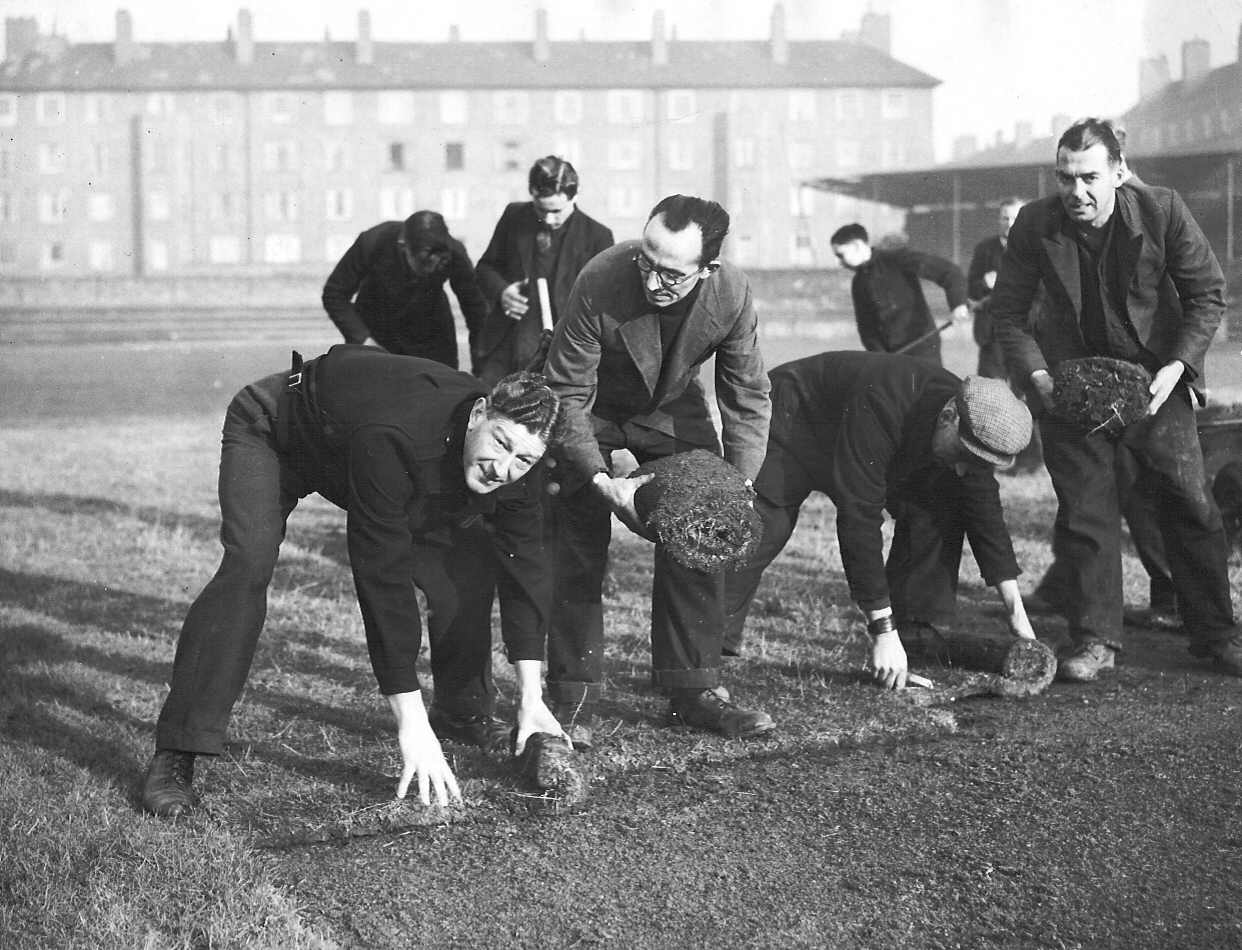Delayed parties are sadly nothing new for Surrey, last year’s 175th anniversary celebrations having to be largely curtailed by the pandemic.
At least there was some semblance of a season in the end, unlike the club’s centenary year of 1945. Back then, Great Britain had been prosecuting the Second World War for six years although the conflict was in its final stages, the war in Europe ending in May and Japan finally surrendering three months later.
That brought a clear focus to Surrey’s delayed celebrations – the need to repair huge damage to The Oval and rebuild a team which could competitive when first-class cricket restarted in May 1946 amid enormous enthusiasm which could not be tempered by what Wisden editor Hubert Preston described as “execrable weather, both wet and cold”.
While Kennington had avoided the worst of the destruction wrought by German bombers during the Blitz – followed by V1 and V2 rockets later on – The Oval was by no means unscathed (see separate panel on groundsman Bert Lock).
Surrey were grateful to the many members who continued paying their subscriptions throughout the war, despite knowing they had no chance of seeing any cricket, but a Centenary Fund for restoration work was established to raise £100,000 and started by the club’s patron, King George VI, who donated £100.
Lock and his men pulled off their miracle – The Oval was ready in time to host the Indian tourists for a three-day match starting on May 11, although the big set-piece occasion came 12 days later when Surrey entertained an Old England XI. It contained many giants of the club’s past in Percy Fender, back as captain, along with Douglas Jardine and Andy Sandham, augmented by Herbert Sutcliffe, Frank Woolley, Patsy Hendren, Maurice Tate and Tich Freeman. Jack Hobbs and Herbert Strudwick were the umpires.
The King joined a huge crowd to watch Surrey make 248-6 and Old England reply with 232-6 to claim a draw. The result mattered little, what it represented for so many was that cricket was back.
Bert Lock
There was no time to waste when Bert Lock started work as the new head groundsman at The Oval.
Succeeding the retired Bosser Martin, Lock had no time for a holiday after being demobbed from the Royal Air Force in 1945. An enormous task awaited him and there were fears that it might take around three years before cricket could be played again at the ground.
At 42, Lock had two decades of experience in groundsmanship behind him, first at the Royal Military College in Sandhurst and then at Exeter when he joined Devon, having made 32 first-class appearances for Surrey between 1926-32 as a seam bowler.
Nothing could have prepared him for his new job. The Oval had been requisitioned at the start of WW2, first being used as the site for a searchlight for German bombers and then to house a prisoner-of-war camp.
It was never occupied but the damage done was immense, the outfield wrecked by large concrete bases on which huts had been constructed plus nearly 1,000 two-foot piles and miles of barbed wire.
Lock had to remove many weeds from the square, levelling the rest of the ground and then importing 35,000 turves from Gravesend Marshes, having walked for miles to find what he wanted.
Building materials to patch up damage around the rest of the ground was in short supply but labour was not, Lock’s staff aided by work parties who produced a miraculous transformation in time for the resumption.
If the outfield was a little slower than before the war, that was a small price to pay and – perhaps because of his experiences trying to dismiss batsmen on Martin’s pluperfect pitches – Lock’s tracks were more friendly to bowlers, much appreciated by the Surrey attack when they dominated the 1950s. He retired from The Oval in 1965 and became the national inspector of pitches.
Nigel Bennett
Finding good captains has always been tricky and Surrey’s predicament – like many other counties – was even greater straight after the war.
The previous incumbent, Monty Garland-Wells, had been injured during the fighting while Errol Holmes – skipper between 1934-38 and who was to return to the post in 1947-48 – was heavily involved in fundraising.
Like their rivals, Surrey could not countenance the idea that a professional should lead the side and after a good deal of casting around alighted on the idea of offering the job to Leo Bennett, a well-known figure in club cricket who had played in the county’s second team prior to WW2. He had appeared for the British Empire XI towards the end of the war, in which he had risen to the rank of Major.
Although the precise details have remained hazy, things became rather confused when Nigel Bennett – having also appeared in the seconds and risen to Major during the conflict – arrived at The Oval to renew his subscription and was promptly offered the captaincy.
Described later on by Sir Alec Bedser as “the cock-up”, it was neither a happy experience for the new captain, who had no first-class experience, nor his team of mostly seasoned old pros. Wisden’s verdict was that Bennett’s “want of knowledge of county cricket presented an unconquerable hindrance to the satisfactory accomplishment of arduous duties,” adding: “This prejudiced the general work of the side.”
Given Bennett averaged just 16.8 with the bat – playing all 26 Championship matches – and bowled just 6.1 overs, he contributed little individually and did not appear again at first-class level.
Namesake Leo went on to make 16 appearances for Northamptonshire between 1947-49, although he also met with limited success.
Surrey’s season
Surrey had to rely largely on players who had played fitfully or not at all for the past six seasons.
While Yorkshire successfully retained the County Championship under Brian Sellars – despite the loss of spinner Hedley Verity while fighting in Italy – it proved a much tougher resumption for Surrey, whose 12th place was their lowest-ever position.
They won just six out of 26 matches, losing 11, the encouragement of beating MCC by an innings and 134 runs at Lord’s in a curtain-raiser soon dissipating. A respectable campaign seemed possible in early August before the final six matches were lost, starting with a four-wicket reverse at home to Middlesex in the match awarded to joint beneficiaries Alf Gover and Tom Barling.
But there were individual successes. Laurie Fishlock (1,963 runs) and Barling (1,500) both enjoyed vintage campaigns despite nearing 40 and Bob Gregory (1,178) had already passed that landmark. Jack Parker, having been selected for the cancelled England tour of India in 1939-40 and never to be offered another international opening, scored 964 Championship runs while taking 45 wickets. Alf Gover’s 113 wickets at 21 showed remarkable hardiness for a fast bowler at the age of 38, aided by fellow pre-war speedster Eddie Watts’s 58.
The 83 victims recorded by Alec Bedser, who like twin Eric had only joined the staff in 1938, would have been far greater only to find himself as England’s spearhead in four Tests. Wicketkeeper Arthur McIntyre received his cap during the season, establishing himself behind the stumps for more than a decade.
Two young players made their first-class debuts in non-Championship matches, spinners Jim Laker and Tony Lock, who were to have an enormous impact on the county’s post-war fortunes.
Test match v India
India had already visited The Oval early in the season and it proved a remarkable match.
They were in trouble at 205-9 only for last pair Chandu Sarwate and Shute Banerjee to put on 249, which remains a record for the last wicket in English first-class cricket, finishing on 124no and 121 respectively. The tourists went on to win by nine wickets.
By the time they returned in mid-August for the third and final Test, they were 1-0 down, having been beaten by 10 wickets at Lord’s and then hanging on desperately for a draw at Old Trafford. Much of that was down to Alec Bedser, who had taken 11 wickets in each match, a remarkable opening to his international career. Aged 28, Bedser’s command of seam and movement at fast-medium pace made him almost unplayable in helpful conditions and a doughty opponent at all times.
The selectors not only wanted to win the series but pull together a squad for the following winter’s Ashes series, in which they were likely to be renewing their battle with Don Bradman.
For the final Test, Bedser was to be partnered by his county colleague Alf Gover, nine years after his previous Test outing, and a third Surrey player joined them as Laurie Fishlock was rewarded for a bumper summer.
Essex leg-spinner Peter Smith’s debut was all the more heartwarming given he had reported to the England dressing room for the Oval Test against West Indies 13 years earlier only to be told that his late call-up had been a cruel hoax.
As it was, the vile weather wrecked this Test. Play on the opening day did not start until 5pm, Wisden suggesting it might not have happened at all but for the large patient crowd who had waited outside since early morning. They watched Vijay Merchant and Mushtaq Ali (59) take the tourists to 79-0 after winning the toss, continuing their partnership on the second to 94. The accomplished Merchant went on to make 128 – both openers being run out – and next best was Vinoo Mankad’s 42 down the order in reaching 331 all out. Bill Edrich’s 4-68 was the best return.
England’s reply reached 95-3 by the close, Len Hutton making 25 and Denis Compton 24no, Prime Minister Clem Attlee among the crowd 0f 26,285, but more heavy rain saw the final day abandoned at 1pm to leave Walter Hammond’s side winners of the series.
Gover’s solitary wicket was not enough to earn him a place on tour – he retired the following year and embarked on an illustrious career coaching the game and in the media – but Bedser, Fishlock and the persevering Smith all travelled down under.
What else happened in 1946?
The aftershocks of the Second World War continued to dominate. At the Nuremburg Trials, 10 leading figures in the Nazi regime were executed for war crimes but Herman Goering escaped the death penalty by taking cyanide. Other trials continued in both Europe and the far east.
The inaugural meeting of the United Nations General Assembly was held at Methodist Central Hall in London.
Clement Attlee’s Labour government, elected with a massive majority in 1945, nationalised the Bank of England and the coal industry. Family allowance was introduced and there was free milk at schools for under 18s. Rationing in the United Kingdom continued and became even more stringent when bread joined the list.
Attlee promised India that it would become independent as soon as a constitution could be agreed, an interim government taking charge.
Winston Churchill, now in opposition, coined the phrase “iron curtain” to describe the division of Europe between western and Russian influence.
France’s wartime leader Charles De Gaulle resigned as head of the provisional government and the Fourth Republic was declared.
The first Cannes Film Festival was staged.
In the first FA Cup final since 1939, Derby County beat Charlton Athletic 4-1. The Football League restarted in August.
Mensa was formed for people with a high IQ.
The Royal Opera House reopened with a performance of Sleeping Beauty by the Royal Ballet.
Alistair Cooke’s first Letter from America was broadcast by the BBC, a series which would continue until his death in 2004, and joined soon after by Woman’s Hour, which continues to this day. Television in Britain restarted and a licence was introduced.












